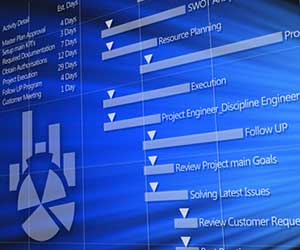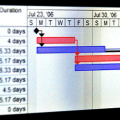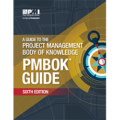
With little exception, missing deadlines reflects poorly on the project manager and sometimes has financial consequences too. Because projects are by definition temporary, someone has authorized the project and expects its deliverables in a timely fashion.
To meet the deadlines, a schedule management plan is produced which is a subset of the project management plan. It’s purpose is to put into place the processes to meet the project deadlines. The main part is the project schedule itself, but the other processes and systems that are established are foundational to ensuring the deadlines are met.
Then, during project execution when issues arise and decisions need to be made, there is a plan regarding what types of things will be revised, by what magnitude, and who will be informed.
The Schedule Management Plan has essentially four parts. Each of these parts can be a heading in the document:
- Schedule Development
- Schedule Control
- Schedule Changes
- The Project Schedule
Schedule Development
In this section the procedures are set in place for schedule development and revision. The person who is responsible for developing it is identified, and the potential input from project team members is discussed. Written procedures for estimating task durations and budgets, contingency levels, and resources are specified for the project.
Because the schedule is constantly scrutinized (at least in every project I know of) a written procedure that answers the 5W’s and 1H (who, what when, where, why and how) puts the schedule on a solid foundation. It’s even more important if multiple people might be creating or editing it.
Also, if your project is bigger than 50 tasks or so, a project scheduling software product is probably an important investment. Microsoft Project is one option, or an online cloud based alternative can be fired up almost instantly. Here are a few real life examples.
- Mr. Project Manager will be responsible for developing and managing the project schedule. Whenever possible, the project team will be employed in the estimation of task durations and resources. Microsoft Project will be used to create the schedule and manage it, and it will be posted on the wall outside of Mr. Smith’s office.
- The project schedule will be developed and maintained by Mr. Project Manager, and the most recent copy will stored in the project management plan binder, appendix A, located in his office. The project manager will estimate task durations and resources, and act as the central go-to authority for schedule changes.
Schedule Control
In this section the procedures are put in place to measure and control the project schedule. Throughout the project, the schedule and cost variances should be known, or calculated regularly, which requires an estimation of the percent complete of each task in the schedule. It requires answering the following questions:
- How will the schedule be measured? What units will be used to measure the completeness of tasks? Percent complete is the most popular, but you can also use hours, total cost, number of units produced, or something else.
- Who will measure it? The project manager is often not the best person to decide whether a task is, say, 25% or 30% complete. On the other hand, making the workers constantly estimate a percent complete of their tasks can be distracting and destroy motivation. It’s a trade off.
- How often will it be measured? I would suggest for project less than about $100,000 a weekly variance calculation will suffice.
Here are some examples:
- Mrs. Project Manager will estimate percent complete for each task on a weekly basis, and update the project schedule and cost variances accordingly. She will verbally consult with the project team as required to arrive at suitable results. The cost and schedule variances will then be communicated to the project team during the weekly progress meeting on monday mornings.
- Mr. Plant Manager will inspect the project daily and report to Mr. Project Manager the percent complete of each task. Mr. Project Manager will update the project management software as necessary and repost the schedule in the lunch room.
Schedule Changes
I’ve seen many instances where a task gets behind and the project schedule is simply changed to suit the new reality. Unless you have no other stakeholders in your project (wouldn’t that be nice!) this practice is meaningless and adds no value to the management of a project. Project schedules cannot be fluid and changed on a whim.
In most cases, someone has approved the expenditure which creates the project and expects to receive its deliverables. That person is called a “project sponsor.” They, or someone suitably above the project, needs to approve the initial project schedule and all changes to it.
Here are the relevant points to consider for this section:
- What are adequate reasons for a schedule change?
- What forms need to be filled out when the schedule changes?
- How much notice do you need?
- Who needs to approve it?
Here are some examples:
- It is important that the project schedule be adhered to. Schedule changes should be minimal and required only on a strictly necessary basis. Factors such as opposition from adjacent landowners, inability to hire laborers, weather, and the like would be considered acceptable but should be planned for in advance. Factors such as workload, poor management and inadequate tools and materials are not considered acceptable reasons. Late supplies and subcontractors are generally not considered acceptable due to the potential for mitigation through better planning.
- The project schedule will only be changed on the request of the project manager for reasons outside the control of the project team. This includes late subcontractors, weather, high water events, and the like. The ‘Schedule Change’ form will be filled out and approved by the project sponsor before the schedule will be changed. This form will need to be submitted within 10 days of the final completion.
The Schedule
For small projects you would generally make the Schedule Management Plan a section of the Project Management Plan (the “schedule section”) and then you have two options:
- Include the schedule itself directly.
- Include the schedule as an appendix.
For large projects it’s more open as to how things are organized. A hard copy printout of the schedule can be multiple pages long, and since you don’t want to revise many documents every time it changes, its official home is either an electronic file like Microsoft Project or a large format printout on the wall. Thus, the Schedule Management Plan generally does not contain the schedule.
Checklist
For most projects you will have the luxury of starting with other similar projects from which you can borrow a schedule management plan. But if your project is unique, or if you need a checklist, ask these questions to ensure your schedule management plan is complete:
- How will the schedule be developed?
The type of software that will be used can be identified as well as the person creating the schedule. Any other methodology such as estimating techniques or resource sharing methods. - How aggressive will it be?
The strategy for contingencies and reserves can be specified, as well as what would constitute a situation in which the reserves will be tapped. - Who will be notified?
Unique stakeholders to the schedule can be identified, as well as their communication needs. A distribution list for the final schedule and/or revisions can be determined. Regular schedule performance reporting needs can be established. - When and how will the schedule performance be measured?
Generally, earned value analysis will produce a schedule variance (SV) and Schedule Performance Index (SPI), as well as a few other numbers which give the project manager insight into how far ahead or behind the project is. Weekly (or other) progress meetings ensure the project team is up to speed with the project schedule and identifies progress to be achieved within the forthcoming progress period. - When (not if!) the project is behind schedule, what actions will be taken to rectify it?
There are a few options. The highest to lowest priority can be specified in the schedule management plan.- Crashing the schedule means adding more resources.
- Fast tracking means performing tasks in parallel that would otherwise be done in sequence.
- Changing the scope of the work to eliminate unnecessary tasks.
- Updating the schedule, which requires the approval of the project sponsor.
- What resources are required, and how will their schedules be managed?
Often projects are constrained by one or several major resources, like a pile driver for a building foundation. Maybe these major resources need some extra contingencies since the whole project moves ahead or behind based on their availability. - What are the assumptions embedded within the schedule?
Every project schedule contains assumptions, from the underlying conditions to the external requirements. If these are not laid out in the plan, the project stakeholders will assume they haven’t been considered which does not bode well when project changes are encountered.
What are your experiences? Please let us know in the comments below how you prepare your project schedules management plans, or if you have anything to add.






